Software for Mariner 10 TV experiment.
Program MarinerView was created for Mariner 10 Raw EDR Images in VICAR Format (PDS),
volumes MVM_0001 to MVM_0015 CD-WO produced by the Science Digital Data Preservation Task.
NSSDC data set ID: PSPA-00108, other data set ID: 73-085A-01U.
This data set consists of the Experimental Data
Records (EDRs) for the 12500 images obtained by the Mariner 10 TV Experiment.The EDRs consist
of unprocessed instrument data in VICAR (Video Image Communication and Retrieval) format.
Each image file consists 22 blocks containing 31944 bytes per block.The first logical record
of the first block contains a single set of VICAR label information. The labels are followed by
700 logical records (one per image line) containing pixel data and engineering data.
This data set is available from National Space Science Data Center (NSSDC).
http://nssdc.gsfc.nasa.gov/
More about this data set at:
http://nssdc.gsfc.nasa.gov/database/MasterCatalog?ds=PSPA-00108
Example 1.
Mercury image before and after despeckle filter.
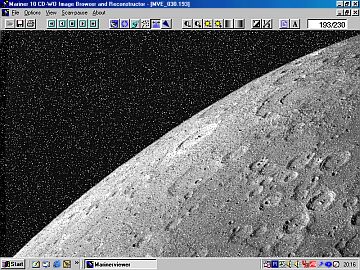
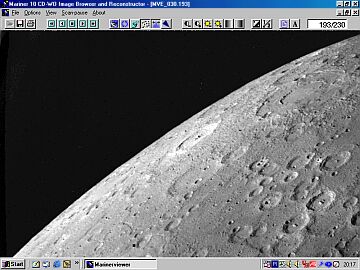
Program options
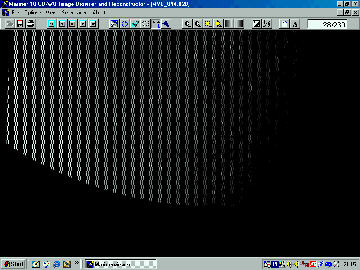
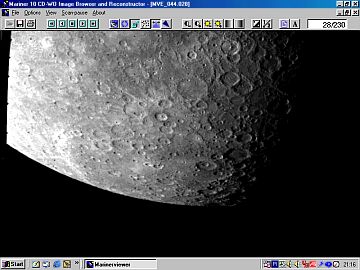
Buttons

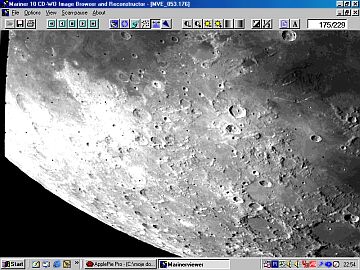
Additional options
Overview of the Mariner 10 mission.
The Mariner 10 mission was the first multiplanet mission carried out by a single spacecraft. In one
flyby of Venus followed by three flybys of Mercury, Mariner 10 returned more than 12000 images to
Earth. The primary goal of the Mariner 10 mission was to obtain data about Mercury, a planet that
had never before been visited by a spacecraft.
Mariner 10 was launched on November 2, 1973 atop the Atlas/Centaur rocket from Launch Complex 36B.
Spacecraft was placed in a parking orbit after launch for approximately 25 minutes, than placed in
orbit around the Sun en route to Venus. The orbit direction was opposite to the motion of the Earth
around the Sun. The spacecraft passed Venus on February 5, 1974 at a distance of 4200 km. It crossed
the orbit of Mercury on March 29, 1974, at a distance of about 704 km from the surface. A second
encounter with Mercury occured on September 21, 1974, at an altitude of about 47,000 km. A third
and last Mercury encounter at an altitude of 327 km, with additional photography of about 300 photographs
occured on March 16, 1975. Engineering tests were continued until March 24, 1975, when the supply of
attitude control gas was depleted and the mission was terminated.

Mariner 10 Television Experiment.
The television system centered around two vidicon cameras, each equipped with an eight-position filter
wheel. The vidicons were attached to telescopes mounted on a scan platform that allowed movement in
vertical and horizontal directions for precise targeting on the planetary surfaces. These folded
optics (Cassegrain) telescopes were required to provide narrow-angle, high-resolution photography.
An auxiliary optical system mounted on each camera allowed
the acquisition of a wide-angle, lower-quality image. Changing to the wide-angle photography was done
by moving a mirror on the filter wheel to a position in the optical path of the auxiliary system.
In addition to wide-angle capability, the filter wheels included blue bandpass filters, ultraviolet
polarizing filters, minus ultraviolet high-pass filters, clear apertures, ultraviolet bandpass
filters, defocussing lenses for calibration, and yellow bandpass filters.
A shutter blade controlled the exposure of the 9.8- by 12.3-mm image face of the vidicon for an
interval that could be varied from 3 msec to 12 sec. The light image formed on the photosensitive
surface of the vidicon produced an electrostatic charge proportional to the relative brightness of
points within the image. During vidicon readout, an electron beam scanned the back side of the
vidicon and neutralized part of the charge so as to produce electric current variations proportional
to the point charge being scanned at the time.
These analog signals produced from the vidicon readout process were electronically digitized
as 832 discrete dots or picture elements (pixels) per scan line, and presented to the flight
data system in the form of 8-bit elements for transmission. Each TV frame-one picture-consisted
of 700 of these vidicon scan lines. All timing and control signals, such as frame start, line
start/stop, frame erase, shutter open/close, and filter wheel step, were provided by the systems
on board the spacecraft.
As it passed the Moon, Mariner provided views of the north polar regions. Mariner 10's cameras provided
a series of six mosaics of the Moon. The path of Mariner allowed images to be obtained of the north
polar region of the Moon, which, because of constraints on paths of other space vehicles, had previously
been covered only obliquely.
In February 1974 at a minimum distance of 5785 km from the surface, Mariner 10 flew by Venus,
accomplishing a series of studies and, simultaneously, a perturbation maneuver in its
gravitational field that assured a continued flight to Mercury.
On March 23, 1974 Mariner 10 began photographing Mercury, and by April 3 it had collected an
unprecedented store of scientific data, including more than 2000 high-resolution television
pictures. Mariner 10 was placed in a orbit around the Sun that returned the spacecraft to
Mercury twice more at a six-month intervals.
Mariner 10 Image Processing.
Image processing - detailed view.
This series of pictures shows how the MarinerView program cleans up errors in real-time pictures.
The first picture in series shows fragment of original picture as received in real-time with a
different bit error rate.
This same picture is shown after the MarinerView program detected and replaced pixels that were
in error. It did this by averaging between the correct neighboring pixels that surrounded each
pixel in error.
Mariner 10 Image Processing Sequences.
Sequence 1 (504 KB)
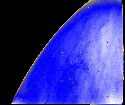 Sequence 5 (318 KB) - version 2.02 only
Sequence 5 (318 KB) - version 2.02 only
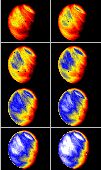 Sequence 6 (420 KB) - version 2.02 only
Sequence 6 (420 KB) - version 2.02 only
Final products.
Reconstructed Image - final product (74 KB)
Despeckled Image - final product (226 KB)
Despeckled Image with errors high density - final product (259 KB)
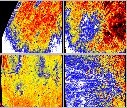 Colored Mercury Images (302 KB)
Colored Mercury Images (302 KB)
Mariner 10 Processed Image Gallery.
Geological features gallery.
Venus atmosphere.
Ultraviolet photographs of Venus showed surprising details of atmospheric patterns. These views of
high and low latitude regions of Venus reveals spiral-like markings and streamline flows.
These images was obtained in ultraviolet light to bring out details in the upper cloud layer,
which appears very bland at visible wavelengths.
 Venus Mariner 10 - high latitude region (250 KB)
Venus Mariner 10 - high latitude region (250 KB)
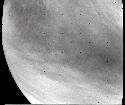 Venus Mariner 10 - low latitude region (187 KB)
Venus Mariner 10 - low latitude region (187 KB)
Miscellaneous.
High-resolution pictures, each only a quarter frame in effect problems with the tape
recorder and transmitter, were obtained at the third encounter.
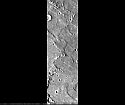 Mercury - tape recorder and transmitter problems example (44 KB)
Mercury - tape recorder and transmitter problems example (44 KB)
Other Links :
Mariner IV First Flyby of Mars - by JPL engineer William L. Momsen
New version with false-colors processing :
For questions about this program, please contact:
mailto:piotr.a.masek@pro.onet.pl
Acknowledgements
I would like to thank:
visitors since 2001.06.17
Last Updated: 2002.07.20
Go Back to Main Menu